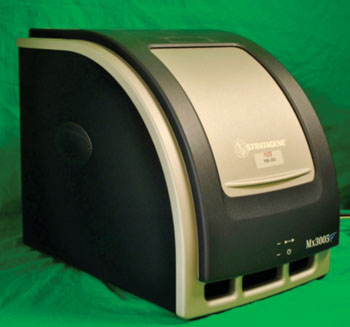Molecular Diagnostic Tool Evaluated for Malaria
By LabMedica International staff writers
Posted on 03 Mar 2014
The diagnostic potential of a recently developed photo-induced electron transfer fluorogenic primer (PET) real-time polymerase chain reaction (PCR) called PET-PCR has been investigated for diagnosing malaria. Posted on 03 Mar 2014
Accurate diagnosis of malaria infections remains challenging, especially in the identification of submicroscopic infections and molecular diagnostic tools that are inexpensive, sensitive enough to detect low-level infections are needed in laboratory settings of resource-limited countries.

Image: The Stratagene Mx3000P real-time PCR system (Photo courtesy of Agilent).
Scientists at the University of Georgia (Athens, GA, USA) working with colleagues in East Africa, obtained 303 blood samples from a survey conducted in the Iringa region of Tanzania. Both thick and thin smears were prepared for each sample and DNA was extracted and isolated as well. All samples were screened using the multiplex PET-PCR assay designed to detect Plasmodium genus and P. falciparum initially in laboratory in Tanzania and then repeated at a reference laboratory, the Centers of Disease Control and Prevention (CDC; Atlanta, GA, USA).
A subset of the samples were tested in a blinded fashion to find the sensitivity and specificity of the PET-PCR compared to the nested 18S ribosomal ribonucleic acid (rRNA) PCR. The Stratagene Mx3000P real-time PCR system (Agilent; Santa Clara, CA, USA) was used to test all samples in both the Ifakara Health Institute (Dar es Salaam; Tanzania) and at the CDC.
Twenty-seven samples out of the 303 tested were found to be positive for both P. falciparum and Plasmodium spp. by PET-PCR when performed in both laboratories. Microscopy detected 11 positive samples (3.63%) among the 303 samples tested, and these microscopy positive samples were confirmed to be positive by PET-PCR. In addition, 16 microscopy-negative samples were found to be positive for both P. falciparum and Plasmodium spp. by PET-PCR. The data showed 100% sensitivity and specificity for the PET-PCR assay and 40% sensitivity and 100% specificity for microscopy.
As the goal moves towards malaria elimination, newer tools that are able to detect all malaria cases, including low-density infections not detectable by microscopy, or rapid diagnostic tests (RDTs), and that are applicable to large-scale screening, are required. The authors concluded that PET-PCR as a new molecular diagnostic tool has similar performance characteristics as commonly used PCR methods, but is less expensive, easier to use, and suitable for large scale-surveillance studies in developing country settings. The study was published on January 27, 2014, in the Malaria Journal.
Related Links:
University of Georgia
Agilent
Ifakara Health Institute














